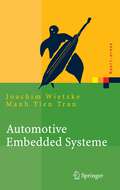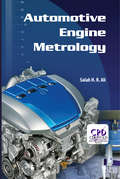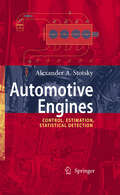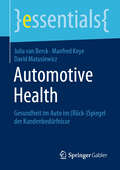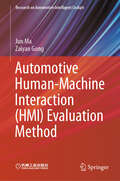- Table View
- List View
Automotive Embedded Systeme: Effizfientes Framework - Vom Design zur Implementierung (Xpert.press)
by Joachim Wietzke Manh Tien TranDie Entwicklung hochkomplexer automotiver Infotainmentsysteme bestehend aus einer Headunit und weiteren Komponenten wie Audio- und Videoelementen, Kommunikationseinheiten, Navigationssystemen und Sensorik erfordert solides Domänenwissen und umfassendes Know-how im Software-Engineering. Das vorliegende Buch gibt eine fundierte Darstellung der softwareseitigen Implementierung dieser Komponenten innerhalb eines komplexen Frameworks. Im ersten Teil des Buches werden wichtige Grundlagen zu Eingebetteten Systemen und den für diese Systeme charakteristischen Methoden des Software-Engineerings vermittelt. Insbesondere werden dabei die Themen Speichermanagement und Systemperformance sowie grundlegende Mechanismen von Betriebssystemen betrachtet. Im zweiten Teil wird eine konkrete, objektorientierte Implementierung eines Frameworks dargestellt. Diese Implementierung zeigt die Umsetzung besonders effizienter Sychronisations- und Kommunikationsprozesse innerhalb einer kompakten und hochperformanten Systemarchitektur.
Automotive Embedded Systems: Key Technologies, Innovations, and Applications (EAI/Springer Innovations in Communication and Computing)
by M. Kathiresh R. NeelaveniThis book is a compilation of the recent technologies and innovations in the field of automotive embedded systems with a special mention to the role of Internet of Things in automotive systems. The book provides easy interpretable explanations for the key technologies involved in automotive embedded systems. The authors illustrate various diagnostics over internet protocol and over-the-air update process, present advanced driver assistance systems, discuss various cyber security issues involved in connected cars, and provide necessary information about Autosar and Misra coding standards. The book is relevant to academics, professionals, and researchers.
Automotive Empire: How Cars and Roads Fueled European Colonialism in Africa
by Andrew DenningIn Automotive Empire, Andrew Denning uncovers how roads and vehicles began to transform colonial societies across Africa but rarely in the manner Europeans expected. Like seafaring ships and railroads, automobiles and roads were more than a mode of transport—they organized colonial spaces and structured the political, economic, and social relations of empire, both within African colonies and between colonies and the European metropole. European officials in French, Italian, British, German, Belgian, and Portuguese territories in Africa shared a common challenge—the transport problem. While they imagined that roads would radiate commerce and political hegemony by collapsing space, the pressures of constructing and maintaining roads rendered colonial administration thin, ineffective, and capricious. Automotive empire emerged as the European solution to the transport problem, but revealed weakness as much as it extended power. As Automotive Empire reveals, motor vehicles and roads seemed the ideal solution to the colonial transport problem. They were cheaper and quicker to construct than railroads, overcame the environmental limitations of rivers, and did not depend on the recruitment and supervision of African porters. At this pivotal moment of African colonialism, when European powers transitioned from claiming territories to administering and exploiting them, automotive empire defined colonial states and societies, along with the brutal and capricious nature of European colonialism itself.
Automotive Engine Alternatives
by Robert L. EvansThis book contains the proceedings of the International Symposium on Alternative and Advanced Automotive Engines, held in Vancouver, B.C., on August 11 and 12, 1986. The symposium was sponsored by EXPO 86 and The University of British Columbia, and was part of the specialized periods program of EXPO 86, the 1986 world's fair held in Vancouver. Some 80 attendees were drawn from 11 countries, representing the academic, auto motive and large engine communities. The purpose of the symposium was to provide a critical review of the major alternatives to the internal combustion engine. The scope of the symposium was limited to consideration of combustion engines, so that electric power, for example, was not considered. This was not a reflec tion on the possible contribution which electric propulsion may make in the future, but rather an attempt to focus the proceedings more sharply than if all possible propulsion systems had been considered. In this way all of the contributors were able to participate in the sometimes lively discussion sessions following the presentation of each paper.
Automotive Engine Metrology
by Salah H. AliIn recent decades, metrology—an accurate and precise technology of high quality for automotive engines—has garnered a great deal of scientific interest due to its unique advanced soft engineering techniques in design and diagnostics. Used in a variety of scientific applications, these techniques are now widely regarded as safer, more efficient, and more effective than traditional ones. This book compiles and details the cutting-edge research in science and engineering from the Egyptian Metrology Institute (National Institute for Standards) that is revolutionizing advanced dimensional techniques through the development of coordinate and surface metrology.
Automotive Engine Metrology
by Salah H. AliIn recent decades, metrology—an accurate and precise technology of high quality for automotive engines—has garnered a great deal of scientific interest due to its unique advanced soft engineering techniques in design and diagnostics. Used in a variety of scientific applications, these techniques are now widely regarded as safer, more efficient, and more effective than traditional ones. This book compiles and details the cutting-edge research in science and engineering from the Egyptian Metrology Institute (National Institute for Standards) that is revolutionizing advanced dimensional techniques through the development of coordinate and surface metrology.
Automotive Engines: Control, Estimation, Statistical Detection
by Alexander A. StotskyIncreasing demands on the output performance, exhaust emissions, and fuel consumption necessitate the development of a new generation of automotive engine functionality. This monograph is written by a long year developmental automotive engineer and offers a wide coverage of automotive engine control and estimation problems and its solutions. It addresses idle speed control, cylinder flow estimation, engine torque and friction estimation, engine misfire and CAM profile switching diagnostics, as well as engine knock detection. The book provides a wide and well structured collection of tools and new techniques useful for automotive engine control and estimation problems such as input estimation, composite adaptation, threshold detection adaptation, real-time algorithms, as well as the very important statistical techniques. It demonstrates the statistical detection of engine problems such as misfire or knock events and how it can be used to build a new generation of robust engine functionality. This book will be useful for practising automotive engineers, black belts working in the automotive industry as well as for lecturers and students since it provides a wide coverage of engine control and estimation problems, detailed and well structured descriptions of useful techniques in automotive applications and future trends and challenges in engine functionality.
Automotive Ergonomics
by Heiner Bubb Klaus Bengler Rainer E. Grünen Mark VollrathErgonomics teaches how to design technology in such a way that it is optimally adapted to the needs, wishes and characteristics of the user. In this context, the concept of the human-machine system has become established. In a systematic way and with a detailed view of the complicated technical and perceptual psychological and methodological connections, this book explains the basics of automotive ergonomics with numerous examples. The application is shown in examples such as package, design of displays and control elements, of environmental ergonomics such as lighting, sound, vibrations, climate and smell. The design of driver assistance systems from an ergonomic perspective is also a central topic. The book is rounded off by methods of ergonomic vehicle development, the use of mock-ups, driving simulators and tests in real vehicles and prototypes. For the first time, those responsible in the automotive industry and in the field of relevant research are provided with a specialized systematic work that provides the ergonomic findings in the design of today's automobiles. This provides planners and designers of today's automobiles with concrete information for ergonomic product development, enabling them to keep an eye on decisive requirements and subsequent customer acceptance.This book is a translation of the original German 1st edition Automobilergonomie by Heiner Bubb, Klaus Bengler, Rainer E. Grünen & Mark Vollrath, published by Springer Fachmedien Wiesbaden GmbH, part of Springer Nature in 2015. The translation was done with the help of artificial intelligence (machine translation by the service DeepL.com). A subsequent human revision was done primarily in terms of content, so that the book will read stylistically differently from a conventional translation. Springer Nature works continuously to further the development of tools for the production of books and on the related technologies to support the authors.
Automotive Ergonomics: Driver-Vehicle Interaction
by Nikolaos GkikasIn the last 20 years, technological developments have set new standards in driver-vehicle interaction. These developments effect the entire lifecycle, from the moment a customer enters a dealership to examine a prospective vehicle, to the driving experience during the vehicle lifecycle, and the interaction with other road users and facilities in pl
Automotive Ergonomics: Driver-Vehicle Interaction
by Nikolaos GkikasIn the last 20 years, technological developments have set new standards in driver-vehicle interaction. These developments effect the entire lifecycle, from the moment a customer enters a dealership to examine a prospective vehicle, to the driving experience during the vehicle lifecycle, and the interaction with other road users and facilities in pl
Automotive FDI in Emerging Europe: Shifting Locales in the Motor Vehicle Industry
by A. J. JacobsThis book examines the dramatic increase in automotive assembly plants in the former Socialist Central European (CE) nations of Czechia, East Germany, Hungary, Poland, and Slovakia from 1989 onwards. Enticed by relatively lower-wage labour and significant government incentives, the world’s largest automakers have launched more than 20 passenger car assembly complexes in CE nations, with production accelerating dramatically since 2001. As a result, the annual passenger car production in Western Europe declined by more than 20% between 2001 and 2015, and alternatively in the CEE it increased by nearly 170% during this period. Drawing on case studies of 25 current and former foreign-run assembly plants, the author presents a rare historical account of automotive foreign assembly plants in the CE following this dramatic geographic shift. This book will expand the knowledge of policy-makers in Europe in relation to their pursuits of FDI and will be of great interest to scholars and students of business, economic history, political science, and development.
Automotive Global Value Chain: The Rise of Mega Suppliers (Routledge Advances in Management and Business Studies)
by Wilson Kia WongToday, some suppliers have grown increasingly powerful and in certain cases, earn revenues that rival or even exceed that of their automaker clients. In the pre-globalisation period, automakers wielded absolute power over their significantly smaller suppliers. This book reveals the upending of this relationship, with the gradual shift in the balance of power from automakers to their suppliers in this era of globalisation. The book examines how suppliers in the global tyres, seats, constant velocity joints (hereafter 'CVJs'), braking systems and automotive semiconductor industries have evolved into powerful oligopolies through a mix of acquisition and organic growth strategies. It also highlights how joint ventures could be strategically deployed as springboards to acquisition, as they enable firms to familiarise themselves with their partners’ markets and operations. Moreover, the book analyses the disruption stirred by the entry of well-resourced technology titans into this industry and their inevitable clash with the traditional incumbents. This book is an invaluable reference for anyone interested in learning more about the automakers’ and now their suppliers’ relentless quest to create market-dominating intelligent driving systems.
Automotive Global Value Chain: The Rise of Mega Suppliers (Routledge Advances in Management and Business Studies)
by Wilson Kia WongToday, some suppliers have grown increasingly powerful and in certain cases, earn revenues that rival or even exceed that of their automaker clients. In the pre-globalisation period, automakers wielded absolute power over their significantly smaller suppliers. This book reveals the upending of this relationship, with the gradual shift in the balance of power from automakers to their suppliers in this era of globalisation. The book examines how suppliers in the global tyres, seats, constant velocity joints (hereafter 'CVJs'), braking systems and automotive semiconductor industries have evolved into powerful oligopolies through a mix of acquisition and organic growth strategies. It also highlights how joint ventures could be strategically deployed as springboards to acquisition, as they enable firms to familiarise themselves with their partners’ markets and operations. Moreover, the book analyses the disruption stirred by the entry of well-resourced technology titans into this industry and their inevitable clash with the traditional incumbents. This book is an invaluable reference for anyone interested in learning more about the automakers’ and now their suppliers’ relentless quest to create market-dominating intelligent driving systems.
Automotive Handbook
by Robert Bosch GmbHThe latest edition of the leading automotive engineering reference In the newly revised Eleventh Edition of the Bosch Automotive Handbook, a team of accomplished automotive experts delivers a comprehensive and authoritative resource for automotive engineers, designers, technicians, and students alike. Since 1936, the Bosch Automotive Handbook has been providing readers with of-the-moment coverage of the latest mechanical and research developments in automotive technology, from detailed technical analysis to the newest types of vehicles. This newest edition is packed with over 2,000 pages of up-to-date automotive info, making it the go-to reference for both engineers and technicians. It includes detailed and simple explanations of automotive technologies and offers over 1,000 diagrams, illustrations, sectional drawings, and tables. Readers will also find: 200 pages of new content, including the electrification of the powertrain Additional coverage on new driver assistance systems and the automated detection of vehicles’ surroundings Updates on the on-board power supply for commercial vehicles New discussions of autonomous vehicles, as well as additional contributions from experts at automotive manufacturers, universities, and Bosch GmbH Perfect for design engineers, mechanics and technicians, and other automotive professionals, the latest edition of the Bosch Automotive Handbook will also earn a place on the bookshelves of car enthusiasts seeking a quick and up-to-date guide to all things automotive.
Automotive Health: Gesundheit im Auto im (Rück-)Spiegel der Kundenbedürfnisse (essentials)
by Julia van Berck Manfred Knye David MatusiewiczAutomotive Health ermöglicht den Menschen, ihre Gesundheit während der Fahrt zu erfassen und damit präventive oder kurative Maßnahmen einzuleiten. Das Konzept unterstützt dabei den selbstbestimmten Umgang mit der eigenen Gesundheit. In diesem essential werden die Ergebnisse einer empirischen Studie vorgestellt, die die Kundenbedürfnisse nach Automotive Health untersucht und herausgestellt hat, welchen Einfluss z. B. der Gesundheitszustand oder die digitale Affinität auf die Nutzenbereitschaft von digitalen Gesundheitsangeboten im Auto haben.Die Autoren:Julia van Berck M.Sc. ist Projektmanagerin für Kooperationen im Gesundheits- und Sozialwesen an der FOM Hochschule für Oekonomie & Management. Dr. med. Manfred Knye ist Leiter des Projekts Einführung Exoskelette, Digitalisierung und Automotive Health der Volkswagen AG und beschäftigt sich mit dem Thema Gesundheit 4.0. Prof. Dr. David Matusiewicz ist Direktor des Instituts für Gesundheit & Soziales (ifgs) und Dekan des Hochschulbereiches Gesundheit & Soziales an der FOM Hochschule für Oekonomie & Management.
Automotive Health in Deutschland: Wenn die Gesundheitsbranche auf die Automobilindustrie trifft (essentials)
by Mustapha Addam Manfred Knye David MatusiewiczAutomotive Health ist ein neuartiges innovatives und ggf. disruptives Geschäftsmodell der Gesundheitswirtschaft, welches die zwei bislang völlig unabhängigen Bereiche Mobilität und Gesundheit verknüpft. Automotive Health umfasst Gesundheitsdienstleistungen im Auto, wie beispielsweise die Auswertung von Vitaldaten der Insassen eines Automobils zur Früherkennung von Erkrankungen. Gegenstand des hier vorgestellten Buches ist eine Übersicht des Status Quo zum Thema Automotive Health in Deutschland und Umgebung. Die Ausarbeitung beschäftigt sich mit Veränderungen von Geschäftsmodellen und deren Philosophie in der Digitalen Gesundheit. Es werden aktuelle und zukunftsorientierte Anwendungsszenarien sowie Chancen und Grenzen dieses Themas aufgezeigt und diskutiert.
Automotive Human-Machine Interaction (Research on Automotive Intelligent Cockpit)
by Jun Ma Zaiyan GongThis book focuses on the evaluation methodology for automotive human-machine interaction (HMI), which aim to reduce driving distractions, lower operational loads, optimize user experience design, and enhance user value.The book is divided into three parts. The first part, consisting of Chapters 1–3, introduces the evolution of automotive HMI and proposes a three-dimensional orthogonal evaluation system for automotive HMI that is comprehensive, systematic, and quantifiable. This evaluation system incorporates all evaluation items into a spatial matrix consisting of three dimensions: interaction tasks, interaction modalities, and evaluation indexes. The second part provides a comprehensive presentation and in-depth discussion of the evaluation indexes. The three rational evaluation indexes are utility, safety, and efficiency, which can be tested by the real-car driving simulator. The four emotional evaluation indexes are cognition, intelligence, value, and aesthetics. In orderto standardize the latter two subjective indexes, this book summarizes common differences in value between Chinese and European users and organizes typical aesthetic orientations in automotive UI based on art history research. The third part introduces the application of this HMI evaluation system in the automotive R&D process, including how to integrate the evaluation into a real product development process to achieve efficient product iteration.This book is suitable for intelligent cockpit and HMI designers, engineers, and researchers. It is also used as a reference for product managers and students in the field of intelligent connected vehicles.
The Automotive Industry and European Integration: The Divergent Paths of Belgium and Spain
by A. J. JacobsThis book chronicles the divergent growth trends in car production in Belgium and Spain. It delves into how European integration, high wages, and the demise of GM and Ford led to plant closings in Belgium. Next, it investigates how lower wages and the expansion strategies of Western European automakers stimulated expansion in the Spanish auto industry. Finally, it offers three alternate scenarios regarding how further EU expansion and Brexit may potentially reshape the geographic footprint of European car production over the next ten years. In sum, this book utilizes history to help expand the knowledge of scholars and policymakers regarding how European integration and Brexit may impact future auto industry investment for all EU nations.
Automotive Innovation: The Science and Engineering behind Cutting-Edge Automotive Technology
by Patrick HossayAutomotive Innovation: The Science and Engineering behind Cutting-Edge Automotive Technology provides a survey of innovative automotive technologies in the auto industry. Automobiles are rapidly changing, and this text explores these trends. IC engines, transmissions, and chassis are being improved, and there are advances in digital control, manufacturing, and materials. New vehicles demonstrate improved performance, safety and efficiency factors; electric vehicles represent a green energy alternative, while sensor technologies and computer processors redefine the nature of driving. The text explores these changes, the engineering and science behind them, and directions for the future.
Automotive Innovation: The Science and Engineering behind Cutting-Edge Automotive Technology
by Patrick HossayAutomotive Innovation: The Science and Engineering behind Cutting-Edge Automotive Technology provides a survey of innovative automotive technologies in the auto industry. Automobiles are rapidly changing, and this text explores these trends. IC engines, transmissions, and chassis are being improved, and there are advances in digital control, manufacturing, and materials. New vehicles demonstrate improved performance, safety and efficiency factors; electric vehicles represent a green energy alternative, while sensor technologies and computer processors redefine the nature of driving. The text explores these changes, the engineering and science behind them, and directions for the future.
Automotive Interaction Design: From Theory to Practice (Springer Tracts in Mechanical Engineering)
by Fang Chen Jacques TerkenThis book focuses on the design of the in-car human–machine interface (HMI) and the design-relevant psychology. It combines a design perspective with an applied theoretical perspective. The design perspective informs the reader about how to set up a design process that puts users at the centre of the design process. The theoretical perspective provides the reader with an understanding of concepts from perception and cognitive psychology, supporting the decision-making in the design process. This is an ideal book for automotive engineers and practitioners in the automotive industry who face the challenge of designing information and entertainment systems, advanced driver assistance systems (ADAS) and automated driving systems (ADS), and the associated HMIs.
Automotive Internetworking (Intelligent Transport Systems #4)
by Timo Kosch Christoph Schroth Markus Strassberger Marc BechlerA complete introduction tocar-to-X communications networking Automotive Inter-networking will introduce a range of new network and system technologies for vehicle safety, entertainment and comfort systems currently being researched and developed. C2X networking is not only a matter of technology, but is also very closely related to policy-making about deployment. This book will provide the background on technical developments but will also discuss the potential benefits, costs and risks. Also discussed will be concepts related to application of vehicle-to-vehicle and vehicle-to-infrastructure communication technologies for various purposes such as automobile safety enhancement, vehicle user applications for comfort and convenience and efficiency along with other potential commercial applications. Application domains will build the starting point for an analysis of the requirements on suitable mobile network technology and the book will look at how well existing and new systems match these requirements. New automotive-specific technologies are presented in detail, explaining millimeter wave short range systems and special automotive network protocols. Specially designed system services and security mechanisms are introduced and system architecture, radio spectrum use, medium access control, network protocols and security concepts and considered. Finally, the book will present the current world-wide standardization activities, deployment strategies and an outlook about the evolvement of inter-vehicle communications in the next decades. Presents a comprehensive top-down approach to the newly evolving car-to-X communications networking Provides a broad overview of all relevant C2X communication topics Written by well known experts in the field Predicts the outlook of the evolvement of inter-vehicle communications in the next decades Includes illustrations and high-level technical sketches of application domains and photographs, 3D renderings and professional graphical sketches of current prototypes
Automotive Internetworking (Intelligent Transport Systems #3)
by Timo Kosch Christoph Schroth Markus Strassberger Marc BechlerA complete introduction tocar-to-X communications networking Automotive Inter-networking will introduce a range of new network and system technologies for vehicle safety, entertainment and comfort systems currently being researched and developed. C2X networking is not only a matter of technology, but is also very closely related to policy-making about deployment. This book will provide the background on technical developments but will also discuss the potential benefits, costs and risks. Also discussed will be concepts related to application of vehicle-to-vehicle and vehicle-to-infrastructure communication technologies for various purposes such as automobile safety enhancement, vehicle user applications for comfort and convenience and efficiency along with other potential commercial applications. Application domains will build the starting point for an analysis of the requirements on suitable mobile network technology and the book will look at how well existing and new systems match these requirements. New automotive-specific technologies are presented in detail, explaining millimeter wave short range systems and special automotive network protocols. Specially designed system services and security mechanisms are introduced and system architecture, radio spectrum use, medium access control, network protocols and security concepts and considered. Finally, the book will present the current world-wide standardization activities, deployment strategies and an outlook about the evolvement of inter-vehicle communications in the next decades. Presents a comprehensive top-down approach to the newly evolving car-to-X communications networking Provides a broad overview of all relevant C2X communication topics Written by well known experts in the field Predicts the outlook of the evolvement of inter-vehicle communications in the next decades Includes illustrations and high-level technical sketches of application domains and photographs, 3D renderings and professional graphical sketches of current prototypes
Automotive Lighting and Human Vision
by Burkard Wördenweber Jörg Wallaschek Peter Boyce Donald D. HoffmanThe safety of vehicle traffic depends on how well automotive lighting supports the visual perception of the driver. This book explains the fundamentals of visual perception, like e.g. physiology of eye and brain, as well as those of automotive lighting technology, like e.g. design of headlamps and signal lights. It is an interdisciplinary approach to a rapidly evolving field of science and technology written by a team of authors who are experts in their fields.
Automotive Management: Strategie und Marketing in der Automobilwirtschaft
by Bernhard Ebel Markus B. HoferDas Automobilgeschäft stellt in vielen Ländern einen bedeutenden Wachstumsmotor für die Wirtschaft dar. Um im globalen Wettbewerb zu bestehen, müssen die Unternehmen der Automobilindustrie ihre strategische Ausrichtung und ihr Marketing optimieren. Dazu bietet dieses Buch eine auf die Branche abgestimmte Übersicht zu allen wichtigen Aspekten für ein erfolgreiches Automotive Management. Erfolgsfaktoren und Lösungsansätze werden von Experten aus Wissenschaft, Beratung und Unternehmen der Automobilwirtschaft umfassend und ausführlich beschrieben und mit zahlreichen Beispielen aus der Praxis illustriert.
